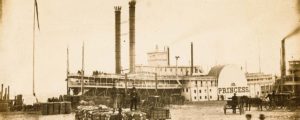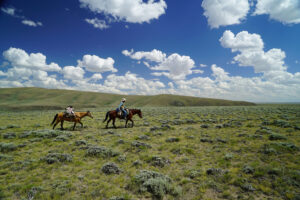He and an accomplice pulled off two holdups at the same spot.
Northbound Southern Pacific No. 20 had just left Burbank station on December 23, 1893, and as it approached Roscoe switch a little after 11 p.m., an armed and masked bandit dropped from the tender into the locomotive cab and ordered engineer Bill Stewart to stop the train. Stewart obeyed. As the train reduced speed, it suddenly veered from the mainline tracks onto a dead-end spur; an accomplice had thrown the switch in advance. The second bandit appeared, firing several random shots from a Winchester to keep passengers and crew in line. The bandits set off a black powder charge by the express car door, knocking Wells Fargo messenger Fred Potts senseless. The pair entered, forced the dazed messenger to open the safe and took $150.
When Stuart was ordered to drive the train off the spur to give the bandits time to escape, he said it would be simpler if they took him hostage. They agreed, and after the trio had walked together a while in the dark, the holdup men disappeared. The engineer then hurried back to the train and drove it to San Fernando, where he alerted Wells Fargo officials.
Posses scoured the area but came up empty. The two outlaws, drifting cowhand William Haven Thompson and rancher Alva Johnson, were already safe in their hideout, less than 10 miles from the robbery scene. Emboldened by their success, the bandits were ready to strike again at the same San Fernando Valley location less than two months later.
While law-breaking in the Salt River Valley of Arizona Territory, Thompson had picked up the moniker “the Kid.” In the fall of 1889 Kid Thompson and fellow Arizona cowboy John Long were convicted of stealing a horse and sentenced to three years in Yuma Territorial Prison. Released on March 20, 1892, Thompson returned to the Salt River Valley but soon pushed west—not for a fresh start.
In California that fall Thompson met Johnson, who owned a feed store in Los Angeles and a ranch in Big Tujunga Canyon, just north of the city. Johnson gave the Kid a job on the ranch, but employer and employee soon had trains rather than cattle on their minds. Their December 1893 train robbery at Roscoe switch went so smoothly they struck the No. 20 there again on February 15, 1894.
That night, engineer David Thomas saw in the engine’s headlight two men standing by the switch to the siding. As he reduced speed, the men signaled for him to stop, one punctuating the request by firing a shot. Thomas decided to keep going, but the masked bandits threw the switch. As the train careened off the end of the spur, Thomas and one of his firemen jumped safely from the cab. The passenger cars telescoped into the tender car and engine. While the passengers escaped serious injury, the impact killed fireman Arthur Masters and a tramp named Arthur Granger who had been riding on the engine’s cowcatcher.
As before, Thompson and Johnson fired several more shots to frighten those on board, set off a small charge to splin ter the express car door and ordered the Wells Fargo messenger to open up. Facing two guns, Harry Edgar complied. The robbers took several small sacks of silver Mexican coins valued at $1,200 and put them inside a larger bag that they made Edgar and another man carry for a distance. Then the masked duo toted it the rest of the way to their horsedrawn wagon and drove away.
The train’s brakeman hurried to a nearby farm, borrowed a horse and rode to the telegraph office in Burbank to report the crime. Posses combed the area the following morning with no luck. Not wanting to draw the attention of authorities, Johnson hid the loot and told Thompson to leave the area until the pursuit had eased. Thompson agreed.
Kid Thompson, according to a statement he made later, visited his father in South Dakota, then drifted through Wyoming, Washington, Oregon and northern California, working temporary jobs. Finally, he and friend Charles Etzler beat a path south to the Johnson ranch, but Johnson said it wasn’t safe yet to divide the silver. He gave Thompson some traveling money and promised to ship the remainder of the Kid’s share to Phoenix. That night Thompson and Etzler hopped a freight train bound for Arizona Territory.
Several days later the money arrived at the Phoenix express office as Johnson had promised. Thompson immediately sold the coins to a fence, who melted them down for the silver content. Before long Thompson was freely spending money with pal Etzler and old friend “Colonel” H.L. Tupper, with whom he had punched cattle years earlier.
In the summer of 1894 Wells Fargo received a tip that the Roscoe switch train bandits were connected to Johnson’s Big Tujunga Canyon ranch. Wells Fargo Detective John Thacker questioned Johnson but was not quite ready to make an arrest. Constable Lester Rogers wasn’t as patient, arresting Johnson and a man named John Smith. Officials soon released Smith for lack of evidence, but they charged Johnson with train wrecking and held him in the Los Angeles County Jail. With the help of two slick attorneys, Johnson confessed to nothing and won his release.
In Phoenix, Etzler knew quite well what had happened to Kid Thompson, and for some reason he told the city marshal. But the lawman sat on the information. Etzler, no doubt afraid the Kid would learn of his betrayal, left town and found a job on a Tonto Basin ranch. He soon “talked” with his employer, who summoned Southern Pacific Detective William Breakenridge. And Etzler kept talking, telling Breakenridge where he could find the remaining stolen coins on the Johnson ranch.
Taking Etzler with him to California, Breakenridge turned over the witness to authorities. Southern Pacific Detectives Miles Bowler and Will Smith recovered Johnson’s share of the loot and then went to Phoenix in search of the Kid. The fugitive and his friend Tupper had already left for the Tonto Basin, but rancher Ivey Crabtree, Maricopa County Deputy Sheriff Billy Moore and cowboy John Kemp gave chase.
The trio caught up to Thompson and Tupper near a box canyon. Feigning surrender, Tupper suddenly leveled his rifle and fired at the deputy. The shot missed, and Tupper and Thompson fled under fire, but right into the canyon. Moore got help from locals Chub Watkins and E.G. Keither before the posse made its move. The Kid grazed Moore’s head with a bullet, but he and Tupper soon gave up.
Two days later, after Thompson waived his rights against extradition, Detectives Breakenridge and Smith transported him to the L.A. County Jail. With the Kid in custody, authorities rearrested Johnson, who broke down as expected, confessed and implicated Thompson. The Kid was charged with train wrecking, a capital offense. He denied involvement in either Roscoe switch train robbery. But at his trial, which began May 1, 1895, at Los Angeles Superior Court, Johnson, Etzler and others testified against him. Convicted and sentenced to death by hanging, he appealed without success and entered San Quentin as prisoner No. 16677 on March 18, 1896, awaiting execution. The Appellate Court again reviewed his case, however, this time overturning the lower court; Thompson would return to Los Angeles for retrial.
Meanwhile, Johnson was sentenced to life for train wrecking and entered San Quentin as prisoner No. 16339 on April 21, 1896. Pardoned on October 21, 1907, Alva Johnson vanished from history.
Kid Thompson tried to escape before his second trail with the help of Tupper, who smuggled him in a gun. Guards spoiled the plot and arrested the colonel. Tried and convicted, Tupper joined the Kid in San Quentin on August 13, 1897, as prisoner No. 17409. On appeal, Tupper had a retrial in Los Angeles and was ultimately released.
Meanwhile, Thompson’s second trial, which had begun on April 13, 1897, ended in his conviction and a life term in California’s Folsom Prison. He began serving that sentence on April 24 as prisoner No. 4077. A third appeal failed, and the onetime “Kid” remained behind bars until paroled on December 19, 1909. A parole violation landed him back in the slammer till his second parole release in 1916. Destitute, ragged and hungry, Thompson showed up at San Quentin’s gate in 1921, begging for assistance. He was allowed to return to prison for three months and then sent away. He died in 1923 while still on parole. The California papers had written about Thompson in the 1890s for his twin robberies and days in court, but he wasn’t well known at the time of his death. Today he is one outlaw Kid hardly anyone remembers.
Originally published in the February 2011 issue of Wild West. To subscribe, click here.




